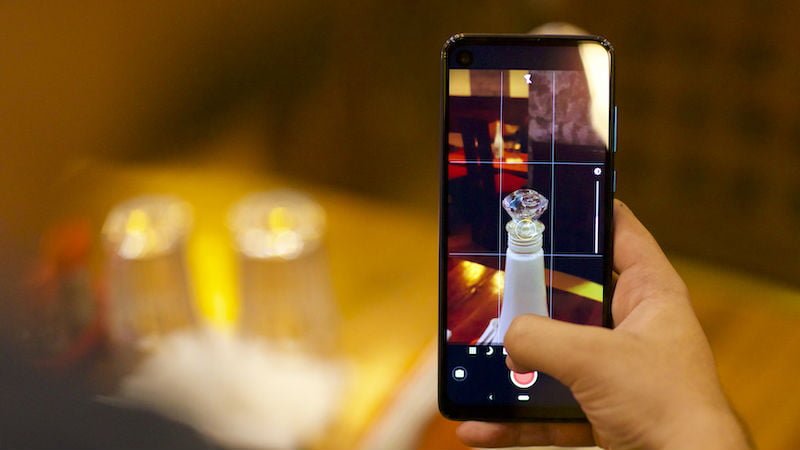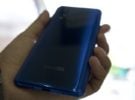In the past few years, Motorola has carved out a niche for itself in the mid-range smartphone segment, and the brand has gained a special affection from users who prefer to use simple stock Android UI with no bloatware. There was a time in between when Motorola was considered as a company which was shipping dated design with its phones, however, looking at the latest release from Motorola we can say for sure that is certainly not the case. Motorola’s most recent launch, the Motorola One Vision aspires to extend a premium feel to the users with a mid-range price tag. We completed our two weeks with the Motorola One Vision and here is a detailed review of the device.

Motorola One Vision Review: Design and Display
The first thing that catches the eye when you look at the Motorola One Vision is the hole-punch display on the top left side of the screen. Notably, Motorola has brought the hole-punch display to its device and it is offering the same design on a mid-range price tag. However, there is also the thing to note that while the punch-hole display lends a premium look to the Motorola One Vision, it is also a little bigger than what you would expect it to be. Owing to this slightly larger punch-hole, the width of the status bar seems more stretched. On taking a closer look from the sides, you will also find that some light leaks from the sides of the punch-hole.

On the rear side, the Motorola One Vision has an exceptionally aesthetically stunning design for a mid-ranger. The device is clad with a curved glass with rounded edges and gradient panel. The two colour options available for the device, which are Bronze Gradient and Sapphire Gradient offer a shining back panel which draws attention and stands out. Also, the fingerprint sensor has a slightly embossed Motorola logo in silver colour, and on the lower side, there is the Android One logo. The camera module which vertically stacked on the rear side might also seem to be a little protruding. Thanks to the curved edges of the phone, the device has a very comfortable hold, and the taller form factor adds to it. The Motorola One Vision has also been claimed to be IP52 rated, thus making it prone to slight liquid damage.
The phone also has the power button on the right edge, which has a rough texture to increase the grip and make it easily identifiable. The volume rockers sit directly above the power button but given the oddly taller form factor of the device these buttons are hard to reach, and so is the upper part of the screen. On the left edge, the phone has the hybrid SIM card slot which can also accommodate a microSD card of 512GB. The bottom edge of the Motorola One Vision comes with a single speaker grille and the USB Type-C.

As for the display, the Motorola One Vision sports a 6.3-inch Full HD+ screen with 1080 x 2520 pixels resolution. The IPS display comes with a density of 432ppi and 21:9 aspect ratio and for the protection,, it sports the Corning Gorilla Glass 3. The highlight of the screen is its high aspect ratio which earns it the name of CinemaVision display and makes it ideal for watching movies, but even then there is a lot of video content which is not optimised for the screen so you will have to deal with black bars on a lot of video content. The tall display of the phone also might become a little intrusive while playing some games and it is possible that you might have to move some thigs around.
Another noticeable thing we found about the display of the Motorola One Vision was the bluish tint and the slightly dull colours. This also came to notice when we turned up the night light on the device, and even with a higher intensity setting, there was a certain amount of bluish tones on the screen.
Motorola One Vision Review: Performance and Software
Surprisingly, unlike a lot of mid-range phones in the market right now which come with Snapdragon chipsets, the Motorola One Vision packs the Samsung octa-core Exynos 9609 SoC clocking a frequency of 2.2GHz. In our usage of the device, the phone did not show any lags and proved to be absolutely smooth when kept up with back to back multi-tasking and heavy app usage. The Android One UI paired with the features of Android 9 Pie made the experience of the phone even smoother.
The device comes in a single variant packing 4GB of RAM and 128GB of storage. The only area where the Motorola One Vision might seem to be lagging is the battery as the device comes with a rather small 3500mAh pack which although goes from 0 to 100 pretty quickly, but also discharges fast. On a normal day of usage with a Google Maps, Spotify, flipping between social media apps like Snapchat, Instagram, WhatsApp and calling, the device required another round of charging around 8 PM. However, charging using the 15W TurboPower adapter included in the box is a breeze as the phone charges quickly, and it takes a little more than 90 minutes for the phone to go from 0 to 100.
What adds to the performance of the Motorola One Vision is the Android One programme, which provides a bloatware-free experience with smooth UI. The device also comes with the promise of monthly security updates for the next three years and two major Android upgrades after Android 9 Pie. There are also additional Moto apps from the brand’s side which enhance the experience of the phone, and this also makes the phone a little more favourable for Moto fans since the features include three-finger screenshot, chop-chop flashlight. There is the usual set of features from Android 9 Pie like the Digital Wellbeing, adaptive battery, adaptive brightness and more.
Motorola One Vision Review: Camera and Imaging
We saved the best of the Motorola One Vision for the last. This is the department, where the Motorola One Vision truly shines. The device packs the 48MP camera sensor paired with a 5MP depth sensor and the 48MP sensor snaps some really impressive shots with detail and depth. However, you should also keep note that the images rendered on the device aren’t rendered with 48MP resolution as you would expect. But, since the device uses pixel binning technology to fuse four pixels into one, the images you obtain are actually in 12MP resolution.
When you look at the camera samples of the Motorola One Vision, you will find that although the details on the images are excellent, the colour reproduction at times might feel a little too saturated for your taste. This is especially true when you click some vibrant colours, on the other hand, depending on the lighting and situation, the exposure on the photos might also seem a little high.
The camera of the Motorola One Vision is also able to capture some beautiful pictures in low-light as well and preserves the details. Sometimes you might experience that the focus doesn’t hold on the subject very well, but with a little adjusting, you can get the camera to snap some very sharp images with proper lighting and distance. Another area where the Motorola One Vision shines is the dedicated Night mode, called the Night Vision which can capture some truly amazing pictures in low light situations with slow shutter speed.
The phone also features a 25MP selfie camera which can capture some decent selfies which also do not lack in detail. However, the colours on the selfies might feel a washed up at times. There is also the portrait mode which is able to detect edges almost all the times except for a few cases. The mode also gives you the option to adjust the amount of blur around the edges. There are also some other modes to play around with like the colour pick feature, live scene filters and portrait lighting effects.
As for the videos on the Motorola One Vision, the phone can shoot full-HD videos at 30fps or 60fps and 4K at 30fps, and the optical image stabilisation (OIS) on the device delivers a smooth output and no-jittery footage both in videos and photos. The phone can also record slow-mo videos at 240fps and 120fps.
Motorola One Vision Review: Verdict
The Motorola One Vision undoubtedly comes as a refreshing breeze in the mid-range price segment with its aesthetic flair and the punch-hole style display along with impressive cameras. Although there are other powerful processors out there like the Snapdragon 675, the Motorola One Vision suffices all requirements that a user can pose including gaming. Even with some down-sides like a little questionable battery life, a slightly underwhelming display, the Motorola One Vision is a worthy option in case you want to buy a phone under Rs 20,000 price range. The device has some very good things to offer when it comes to design, camera and the unique 21:9 display.


































